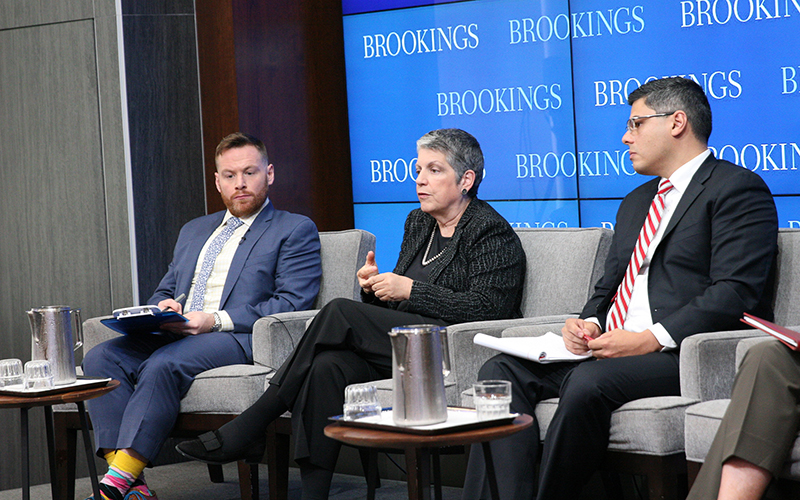
Janet Napolitano, former Arizona governor and former secretary of Homeland Security, said that if lawmakers are not able to act, then courts will need to “step in and protect those 800,000 young people” who are protected by the DACA program. (Photo by Joel T. Vernile/Cronkite News)

Former Arizona Gov. Janet Napolitano, who served as Homeland Security secretary in the Obama administration, predicted that the Trump administration’s immigration policies would energize Latino voters and help turn Arizona blue. (Photo by Joel T. Vernile/Cronkite News)
WASHINGTON – Former Arizona Gov. Janet Napolitano called for statutory protection for DACA recipients, but expressed little confidence Friday it will come from a Congress that has been unable to pass real immigration reform the country “sorely needs.”
Napolitano was Homeland Security secretary when the Deferred Action for Childhood Arrivals program began in 2012, and denounced the Trump administration’s plans to rescind the program, saying recipients have been living in “fear and trepidation” since the announcement came down.
So Napolitano, now president of the University of California system, has turned to the courts, suing to save the DACA and urging the court to “step in and protect those 800,000 young people” who are protected by the program.
“These DREAMers … have to walk around always looking over their shoulders to see if there is an ICE (Immigration and Customs Enforcement) agent,” Napolitano said at a Brookings Institution panel on “Immigration Policy in Trump’s America.”
The panelists, who included a former immigration chief under President Bill Clinton and a policy adviser from the advocacy group UnidosUS, shared a dim view of the current administration’s policy.
Doris Meissner, former commissioner of U.S. Immigration and Naturalization Service, said that despite fears – or threats – of massive deportations if DACA goes away, there is “a huge gap between perception and reality” on immigration and deportation.
See related story:
Napolitano has hopes for NAFTA talks, despite strained U.S.-Mexico relations
President Barack Obama enacted DACA by executive order in 2012, after Congress failed to pass a comprehensive immigration reform bill. Under the program, immigrants who were brought to this country illegally as children could apply to have any deportation action deferred, allowing them to stay here, and get papers allowing them to drive, work and go to school.
Applicants had to pay a fee and meet a number of criteria, including age requirements, being in school or the military and having no criminal record, among others. DACA protection did not bestow any sort of citizenship status and was good for two years, after which a recipient could reapply.
Trump, who campaigned on a promise to immediately eliminate DACA, has wavered since taking office, and recently praised the character of DACA recipients, also known as DREAMers. He left it to Attorney General Jeff Sessions to announce that the administration planned to end the program because its enactment was an unconstitutional overreach of presidential authority by Obama.
The Trump administration said the Department of Homeland Security will continue considering current applications for DACA, but it stopped accepting new applications on Sept. 5. DHS will accept renewal applications until Oct. 5, but only from people whose current coverage expires before March 5. After that people will lose protection as their coverage expires.
While a DREAMer without DACA protection is eligible for deportation, DHS officials have said they would not be a high priority for deportation and that they did not plan to share DACA recipients’ personal data with law enforcement officials. But the data would be available “as needed” by police, DHS said.
That uncertainty has advocates and DACA recipients frantic. But Meissner said there will not be “an automatic deportation” or a “targeted effort” against DACA recipients as a result of the administration’s “wind-down” of the program between now and March.
Instead, she said, DACA recipients will lose the work authorization they got as part of the program, will no longer be able to go to school and “they will fall back into the underground economy.” But most of them will still probably remain in the U.S., Meissner said.
Napolitano agreed that mass removal is unlikely.
“The notion that you just flip a switch and remove 800,000 people is a myth,” Napolitano said. Deporting undocumented people involves multiple processes and “each requires resources and takes time.”
She described the process after an ICE officer finds and detains someone who is in this country illegally. The case must go through an administrative process, where a judge must decide whether or not to deport them, after which transportation has to be arranged – assuming that their home country will receive them.
Trump’s call for a border wall also came in for criticism from the panel, with Napolitano saying the idea of an “impermeable structure” across the entire Southwest border is unrealistic and a waste of resources, noting that costs will likely be “in excess of $20 billion.”
She also criticized “ramping up” the number of Border Patrol and ICE. Instead of adding thousands of officers, she said the U.S. should focus more on technology, on air coverage, and “working with our neighbors to the south” to keep people from trying to sneak across the border.
“Waiting until the traffic hits this mythological structure will not suffice,” Napolitano said of the border wall.